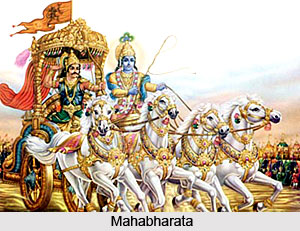 Religion in ancient India has existed since time immemorial. Further, the birth and development of different civilisations in the country paved the way for growth of different religions. However, in the ancient societies, people worshipped the natural forces as it is believed that there were no religions in the pre-historic times. The Vedic texts reveal real popular beliefs and practices as yet uninfluenced by the sacerdotal class and they contain matters reflecting popular beliefs and practices. Thus, ever since the dawn of civilisation, human beings have been holding some naive beliefs and performing certain rites.
Religion in ancient India has existed since time immemorial. Further, the birth and development of different civilisations in the country paved the way for growth of different religions. However, in the ancient societies, people worshipped the natural forces as it is believed that there were no religions in the pre-historic times. The Vedic texts reveal real popular beliefs and practices as yet uninfluenced by the sacerdotal class and they contain matters reflecting popular beliefs and practices. Thus, ever since the dawn of civilisation, human beings have been holding some naive beliefs and performing certain rites.
Around 6th century BC, Buddhism arose in the ancient Indian society as a protest against sacerdotal practices. Atheistic ideas also developed side by side in the society. The six orthodox systems of philosophy exercised profound influence on the society. The most powerful impact was created by Vedanta Philosophy which declared all creatures to be like sparks from the one eternal fire that is Brahman. This went a long way in fostering a sense of unity among the people and compassion towards other creatures. The Yoga philosophy taught people how to concentrate the mind and that mind control was at the root of peace and progress. It advocated various Yogic practices some of which are relevant even today. The Upanishads did not do away with sacrifices and other religious rites. But, they did not look upon the same as the sole means of salvation. The Isa Upanishad clearly says that, while sacrifices enable one to cross the ocean of death, knowledge of the Supreme Being ensures the elimination of rebirths. In a way, the Upanishads prepared the ground for Buddhism.
Certain curious practices are referred to in the Brahmanas. From the Shatapatha Brahmana it has been found that a wife did not take meals in presence of her husband. Though the husband used to take food in presence of the wife serving it, yet one desiring a vigorous son was debarred from this practice. Some beliefs and practices, relating to the disposal of the dead body, are noteworthy. Just before death a person`s body was placed on the ground, purified with cow dung and spread over with grass. After expiry the body was washed and smeared; the hair and beard of the departed were closely trimmed and the nails pared. Afterwards the body was garlanded, and covered with a new garment. In the cremation ground, incantations were recited to prevent the evil spirits from harming the spirit of the departed soul.
Each and every religion of India is known for its own religious beliefs and practices. Some of the Holy Scriptures of the country such as the Vedas, Upanishads and the great epics (Ramayana and Mahabharata) give references of the popular ancient religious practices. The ancient literary texts speak about the intricate `Yagnas`, sacrifices and significance of fire in a ritual, all of which were essential part of the common religious practices. One of the earliest regions to be found in the country is Hinduism. The beliefs and customs of this religion have not changed. After the development of this religion, Buddhism and Jainism also developed. And with these religions new practices and spiritual knowledge principles also came into existence. With these new beliefs, customs and practices the meaning of religion completely took a new turn. The religions of ancient India placed a strong basis of the various religious beliefs and practices, which are followed by the people even today.






































